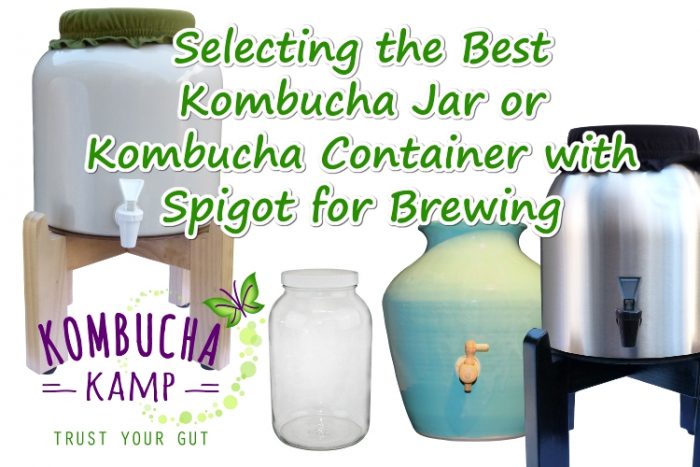Brewing Location: Selecting the Ideal Spot for Kombucha, Kefir, JUN and other Ferments
Working with fermentation cultures is kind of like a cross between caring for a pet and a plant. While your SCOBY isn’t going to crawl out of the jar and ask to sit on your lap, it will change based on the environment. Just as a plant will droop from too much sun, or a frog needs access to water, the brewing location for your Kombucha, kefir, JUN and other ferments can affect the success. 
These are the most important factors to consider when searching for the best brewing location for each ferment:
- Temperature
- Airflow
- Exposure to Sunlight
- Convenience
- Conditions to Avoid
Each of these variables can have a positive or negative effect on the “womb” like atmosphere of the brew. That environment should support the bacteria and yeast as they progress through their lifecycle. After a few successful batches, often a “mini-microbiome” is created where the brew is stored as the microscopic organisms inhabit the space. Creating this ideal location leads to a lifetime supply of healthy brews and tasty batches.
*Remember: It’s okay to move the brewing location around for the first few batches until you hone in on the right combination of elements.
What’s the Most Common Brewing Location for Home Ferments?
Want to skip the rest of the article? For most people, a kitchen counter is the simplest and most convenient location, provided it is a few feet away from the stove to avoid fumes or splashes that could cross-contaminate the brew. If the counter is too occupied, other popular choices include a cupboard slightly cracked for airflow or on top of the refrigerator. Use caution when lifting jars of liquid as they can be quite heavy.
- Kitchen counter
- Kitchen cupboard
- On top of refrigerator
- Pantry
If the kitchen and pantry are simply a no go, it’s time to get creative. Perhaps there is a nook available in a closet, spare bedroom or even the garage or basement. Keep in mind that temperature is key so you might want to use a heating mat (LINK TO HEAT MATS) anywhere that isn’t kept warm year round. It’s also best to avoid damp locations which may lead to mold.
- Closet
- Laundry room (next to dryer for warmth)
- Bedroom
- Basement or Garage (use caution to avoid exposing the brew to chemicals, damp locations, or extreme temperatures)
The list of potential brewing locations could go on and on. To help determine the best brewing location, read through the variables listed below and then explore your home to see what special place emerges as your ideal fermentation zone!
A Word About Continuous Brew Kombucha (or JUN) Brewing Location
We already know that if you love homemade Kombucha or JUN, Continuous Brew is the easiest and fastest method. But when it comes to brewing location, CB provides great advantages as well. That’s because Continuous Brew creates the most powerful “mini-microbiome” as mentioned above, with a very strong base of Kombucha or JUN in the vessel. And, CB allows for the least amount of maintenance or mess at bottling time. With less clean up and no need to remove SCOBYs in between batches, the choice for CB brewing location is very flexible. Read up more about Continuous Brew here. And learn about the differences between Kombucha and JUN here.
Temperature
Temperature is key for all types of fermentation. When working with microorganisms, it’s important to understand the best climate for them to thrive. Often, cultures are somewhat flexible but if it is either too hot or too cold, they often suffer and may even die.
Ideal Temperature Chart
| Ferment | Temp Range | Ideal |
| Kombucha | 75-85°F (24-30°C) | 80°F (27°C) |
| JUN | 70-80°F (21-27°C) | 75°F (24°C) |
| Water Kefir | 68-78°F (20-26°C) | 75°F (24°C) |
| Milk Kefir | 65-75°F (18-24°C) | 72°F (22°C) |
| Sauerkraut | 65-80°F (18-27°C) | 72°F (22°C) |
| Fermented Veggies | 60-85°F (16-30°C) | 70°F (21°C) |
Of course we’re not saying it’s impossible to make Kombucha or other ferments outside this range, but the flavor and results are simply vastly superior when done right. Just like quality ingredients, good sanitation, strong starters, and enough time, proper temperature has a big impact on the final product. We find ourselves eating much more fermented food when it tastes the best, even though we know we should be eating more when the batch wasn’t as good. It’s human nature! So if you need to figure out how to keep Kombucha warm during the brewing process, look no further, these heat mats can make that difference.
Some questions to consider:
- Where does my home stay warmest?
- Does it ever get too warm?
- Is it ever too cold?
- Does it remain consistent or does the temperature fluctuate?
- If no place in the home will maintain the culture in the proper range, does the location have access to an electrical outlet for a heating system?
Airflow
Kombucha and JUN are both aerobic ferments. This means that they need exposure to oxygen in order for the fermentation process to occur. As such, it’s not a good idea to sequester those brews into any tightly sealed area that may limit the amount of air available.
A cupboard can be tightly sealed or if it is propped open or opened once or twice a day, it may provide sufficient airflow. A closet can also be a warmer location and again, as long as there is some movement of the air within through casual use, that will work just fine.
Milk kefir and water kefir can be fermented either with an open top or closed top, so airflow isn’t as crucial for those ferments. We ferment our milk kefir and water kefir with hard lids to minimize cross contamination potential and they do very well, but they get attention almost every day. If you are handling the kefir less often, airflow will be more important and so a cloth cover may work better.
Exposure to Sunlight
The UV rays of sunlight are antimicrobial by their nature. This is great when it comes to drying laundry outside on the clothesline but not so great when it comes to our ferments. Avoid placing them in direct sunlight to prevent exposing them to UV rays that could damage the organisms in your cultures. All KKamp Continuous Brew vessels are opaque in order to maintain the best health for the SCOBYs long term.

Ambient or indirect light coming through a window will not create a problem. If you want to take advantage of the sun’s full warmth, we’d recommend using an opaque vessel or putting a t-shirt on your jar!
Convenience
Consider this: if you think your ideal brewing location is in the basement, but then you have to lug heavy jars of sloshing liquid up a flight of potentially steep stairs, it may not be the best choice. Gaming out your Kombu-Cha-Cha in advance will help to identify any potential pitfalls with that brewing location. Of course, you can always shift the brewing location as needed.
Most important will be access to a sink for making the brew and flavoring/bottling/clean-up.
And of course you will need to be able to taste the brew frequently. This is how you will determine when it is ready, so it should be easy to access.
For milk kefir and water kefir, fermentation time is shorter, so keeping them close by is even more important. Sometimes out of sight is out of mind!
Conditions to Avoid
 In general, we advise keeping ferments away from these potential contaminants or to avoid a sick or moldy ferment:
In general, we advise keeping ferments away from these potential contaminants or to avoid a sick or moldy ferment:
- Cigarette smoke
- Stuffy or unventilated areas
- Damp areas
- Grease and cooking fumes
- Direct sunlight
- Excessive temperatures
- Pollen (from indoor or outdoor plants)
- Toxic chemicals (cleaners, air fresheners, etc)
- Near other ferments (leave at least a few feet between ferments)
Most fermentation cultures have evolved to create hardy microbiomes that are not easily invaded by mold or other contaminants. However, like all food, they can potentially get infected. And like all food, it will be plainly obvious due to the presence of mold.
Provided you follow the best practices advised above, the likelihood of mold is reduced greatly. Of course, if you notice your brews are just not taking off and all of the variables have been dialed in, then perhaps taking a deeper look at your environment will yield a culprit. More than one customer has written us to say that they discovered mold in their brewing location after it infected their brew. More Do’s and Don’ts of brewing can be found here.

